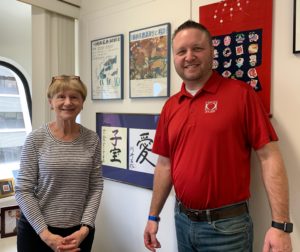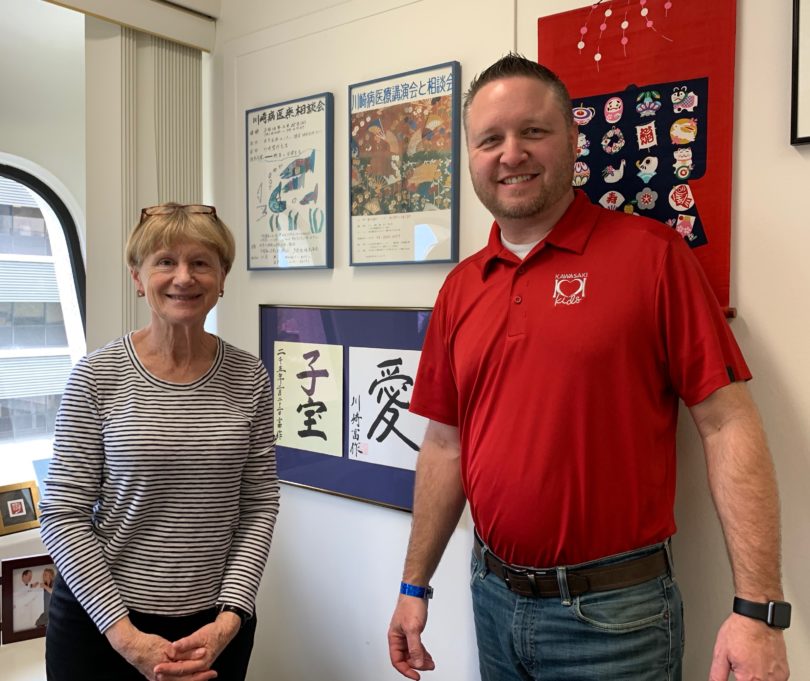
Last week, I had the pleasure of heading to sunny San Diego for a nonprofit and social media conference and to meet with Dr. Jane Burns. Coming from the winter weather recently in Colorado, I was looking forward to 75-degree weather in California. I was in for a shock as I got off the plane and was hit with fog, rain, and cold. I quickly dialed up my cousin to pick me up and show me a great local place for a fantastic breakfast. Shrimp, avocado, egg scramble while sitting on the patio overlooking the water was a fantastic way to start my day.
Questions about Kawasaki Disease (KD)are always on a parent’s mind after being informed their child has been diagnosed. As I prepared for my trip to San Diego, I knew I wanted to make some time to meet the famous Dr. Jane Burns. Dr. Burns has been studying KD for over 30 years and is recognized as one of the leading KD doctors in the United States.

I set my appointment for Thursday and decided I would reach out to our followers and get their questions for Dr. Burns. The questions came pouring in quicker than I could get them copied over to a word document. There seemed to be a common thread and duplication on a lot of the questions which told me those are ones we need to focus on.
As Thursday rolled around, I left the San Diego Convention Center in an Uber and headed 20 minutes away to meet with Dr. Burns. There wasn’t an exact address for me to give the driver to get on to the enormous medical center, but we set off anyway. We got to an area where I thought we were close, so I decided to get out and pay my tab. I was wrong! After talking with a few locals and med students it was determined I was still 2 miles away. I quickly searched my Uber app for another driver that might be in the area, however, no cars were in the area. Glad I wore my tennis shoes because it was time to take a brisk walk to hopefully make my appointment on time. After about 30 minutes of walking, checking my phone and a map the receptionist sent, me I finally arrived. Thank goodness I planned ahead and left early!
I arrived at the medical center and met with Dr. Burns’ assistant in the actual lab. It was pretty inspiring seeing where a lot of KD research was actually happening while I was there. As I was chatting with the researchers, I got the overwhelming feeling they truly loved what the do. Finally, the chance to meet the infamous Dr. Jane Burns in person, ask my questions, learn, and get inspired. We talked a bit about my son, Cooper, and what life looks like for him as he gets closer to needing a kidney transplant and bypass heart surgery. Dr. Burns is passionate and determined to find a cause for KD, a test to easily diagnosis KD, and ways to grow her research program for the benefit of all.
I could have hung out there all day and geeked out on all the cool research tools and information. As I left and waited for my Uber to pick me up, I remember thinking how lucky we all are to have such a wonderful doctor with such a passion and drive fighting for our children.
Below are the questions I asked Dr. Burns and the answers she so graciously provides. We love your comments, support, and eagerness to grow awareness. Reach out and engage with us. Make a difference today!
Questions/Answers

Children are having some unexplained chest pains on and off. If a child has no known heart dilation and clean bill of health post KD, how should parents best deal with this? Is there a cause associated with this?
At this time, we have no reason to suspect any abnormality of the heart or blood vessels that would cause this. Anxiety and hyperventilation are both common in pre-teens and some of the chest pain complaints will fall into that category. Reassurance and counseling are ways to diffuse these concerns. Often children are picking up on the anxiety of their parents.
Other children may have acid reflux that can be relieved with calcium carbonate (Tums), which is safe and easy to carry around as tablets. Having pain that is relieved with minutes by several chewable Tums makes the diagnosis of acid reflux.
To be clear, based on current evidence, children with always normal echoes after KD will not have future heart problems due to their KD.
Why do some children take aspirin longer than others?
Outpatient low-dose aspirin therapy for KD is directed at inhibiting the platelets (small, “sticky” cells in the blood that participate in blood clots) and possibly preventing them from sticking to the lining cells of the blood vessels (endothelial cells) so that those cells can heal. For children with aneurysms, aspirin is directed toward preventing blood clots in the aneurysms. Aspirin therapy may be continued longer in some children for the following reasons:
- Blood tests show that the platelet count is still very elevated or that inflammation is still present
- Aneurysms are present.
Will taking aspirin cause Ryes Syndrome in my child?
Reye’s Syndrome is a serious inflammation of the liver and brain that occurred in the past in children infected with either the influenza virus or the chickenpox virus (varicella virus) who received moderate doses of aspirin to control fever during their illness. When aspirin to control fever in children was banned, the syndrome virtually disappeared. There was never any evidence that low-dose aspirin (one baby aspirin table or less) could be a trigger for Reye’s Syndrome. Despite this, many physicians will stop aspirin therapy temporarily if there is a concern of either the influenza virus or chicken pox. This seems reasonable. Your child will not get Reye’s syndrome from taking aspirin in the setting of KD.
If a child has no heart dilation or aneurysm and is in good health, what is the standard for getting an echo done for the rest of his/her life?
The recommendation of the American Heart Association is to discontinue follow up and any further echocardiograms between 4weeks to 12 months for patients whose echocardiograms have always had a Z score for the right coronary artery and the left anterior descending artery of <2.0 (see handout for parents on Z scores). This also assumes that a) the echo was of good quality and b) that is was interpreted by a cardiologist with the appropriate qualifications to read an echo of the coronary arteries. In most cases, to obtain a good quality echocardiogram in a child < 3 years, some form of sedation is needed.
What is the follow-up protocol for children who have had no heart issues from KD?
The patient should have an echo in the hospital as soon as the diagnosis of KD is made. A second outpatient study should be performed 7-14 days later. A third echo at 8 weeks or at one year is optional if the first two have been completely normal.
What long term health changes are associated with KD? What tests should adults have (who had KD as a child)?
Individuals who are currently adults likely had their initial KD at a time when echo quality was not very good. One option is to get a CT calcium score (not scan) to look for any evidence of calcium (scarring) in the arterial wall. A normal calcium score in young adults should be zero. If the score is not zero, that person should be referred for follow-up to an adult cardiologist who is knowledgeable about KD.
At this time, there are no proven health issues later in life in individuals who had a normal echo. All patients with aneurysms at any point in their illness must be followed for life by a cardiologist.
Does research indicate any correlation of kids with KD and mothers that used infertility drugs such as Clomid?
No known relationship.
Is there a genetic component. Is it something I need to watch out for in my other children.
KD is a genetic condition and can be passed to future offspring who were not alive at the time of the first case in the family. It is not contagious. Other children who were alive (and therefore exposed) at the time that the first child developed KD will NOT get KD later in life and are not at risk. They do not carry the correct genetic profile and therefore are no susceptible.
The patient who had KD has an increased risk of having offspring who also develop KD although we do not know the exact risk.
What is known about long term effects of IVIG?
IVIG circulates in the blood for up to a year. There are no known long-term effects.
As a child hits puberty, are there certain stress tests or other tests that need to be done?
Testing is only recommended for children who developed aneurysms whether or not they remodeled.
Joint pain seems to be a very consistent complaint in our KD children. Are there any studies being done to find out the reasoning for that? Are there any good treatments that we can use for that pain?
Joint pain during the subacute phase of KD after discharge from the hospital is common and occurs in about one-third of patients. It can be successfully treated with naproxen (Aleve) but this should only be done under the supervision of a physician.
Can children get vaccinated after having KD? How long if any do, they have to wait?
Children must wait for 11 months after receiving IVIG before they receive live virus vaccines (measles, mumps, rubella (MMR), and chickenpox). They may receive killed vaccines such as DPT on the regular schedule.
Is there a particular reason some children are resistant to the first dose of IVIG?
We do not currently understand why roughly 15% are resistant to IVIG and require additional medication to stop the fever.
Is there a direct correlation between the region of the country and the number of cases?
KD appears to be more common in Southern California, but it not clear if this is because of increased awareness and good reporting or if this is actually true.
If a child has a clean bill of health are there still any diet restrictions or modifications, they need?
None
For those of our children who missed the 10-day window and did not get IVIG, what complications do we watch for?
All children with KD should be treated if there is evidence of ongoing inflammation or an abnormal echo. There is nothing magic about “10 days”. That was the enrollment criteria for the large national trial of IVIG in the 1980s and has nothing to do with a cutoff for treating KD patients with IVIG.
How close is the research to having a test that will detect KD easily?
Plans are underway for a computer-based algorithm (decision support tool) that will be tested in a consortium of Emergency Departments throughout the U.S. within the next year. A blood test devised by a group in London is awaiting funding to make a point-of-care device so that children can be more widely tested to see if the blood test will distinguish KD from other rash/fever illnesses in childhood.

Comments 14
How exciting to have met and spent spent time with Dr. Burns . Lots of good information from the questions that you had asked Dr. Burns thanks for posting . my daughter is almost 19 had KD when she was two very minor aneurysm at the time of diagnosis and has been followed since then she had a follow up at 12 and a full cardiac work up at 18 will show no issues .
Author
Thank you and so glad your daughter is doing well.
Thank you for taking the time to have the interview and posting this. As a parent, we are always looking for the most recent information. Much appreciated!
Shawn, thank you for taking the time to ask these questions and to bring us the answers. For me, it was reassuring to hear the consistency between what I’ve heard from Dr Jone (who is fabulous) and the responses given by Dr Burns. The misinformation out there being told to families by some doctors is scary. The lack of knowledge about KD in the medical field is scary. Thank you for all you do to spread awareness.
My grand daughter 1 and 8 months old was diagnosed kd last jan.19 and discharge in the hospital at jan 22,2019..but 3 days ago she has a fever and we continue give her aspirin.then the fever gone,some rashes came out on her face and she’s irritated.
I was 5 months pregnant when my then 2 year old was diagnosed with KD, Sept 2018. Is my 4 month old at a higher risk of KD bc I was pregnant? Or bc he is a sibling born after the KD?
Wonderful questions and answers.
Our child was denied IVIG based on the “10 days”. We were turned away on 6 separate ocassions. I hope that more hospitals and doctors are educated on this illness to help other children more quickly.
I love that what the future may hold for easier diagnosis.
Thank you so much for sharing.
I learned so much from her responses.
I appreciate the information but it doesn’t match the information Im given by others. I am under the understanding that we have to continue to monitor periodically our older KD kids. I think it dangerous to assume that no future follow up is needed which is how I am reading this. We have a 17 year old KD kid and another younger child born with BAV. Our cardiologist in Denver is not just letting our KD go on with no follow up even with his good results.
My son had Kawasaki Disease at age 11. He was adopted. Had check up at 1 year and still had a slightly enlarged valve in heart, went back 2 yrs. still slight. I think a 3rd visit is now due. 5 yrs and he is 16 now. Is it possible for him to get it again? What kind of testing should I get him at 5 years? Do I take him to any Cardiologist or a special one? The Drs. who diagnosed him are now moved far away. I was using one that was closer to me. is that where I should go. He has no symtoms that I am aware of, but if there could be symtoms what would I watch for at 16 yrs old? Thank you for a response.Pam
My son had KD in 2005. Back then there were studies being done that linked this disease to carpet cleaning and use of chemicals. Is there any link to everyone cleaning so much now because of Covid19 to KD? Also, should I be worried about my son, is he at higher risk of getting Covid19?
Author
As of right now your son is not at higher risk of COVID at all. As for the carpet cleaning there are a lot of kids that were around carpets being cleaned and then became sic. our child is one of those. The child still needs the gene component mixed perfectly with the trigger to get KD.
Jane,
My daughter, who is now 2 months shy of 12 had Kawasaki’s when she was 3 years old. She has subsequently received a clean bill of health. I’m curious to know if there are any studies to suggest that the COVID vaccine is either safe or not safe for former Kawaski patients. Is there an increased risk of myocarditis?
I’d welcome being pointed to any studies that have been done…Thank you so much for all that you do.
What is the link between KD and POTS Syndrome?
Author
There are no connections between the two that we are aware of. Thank you